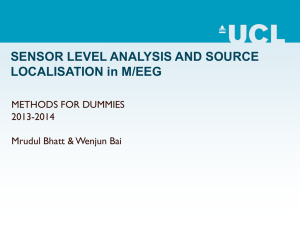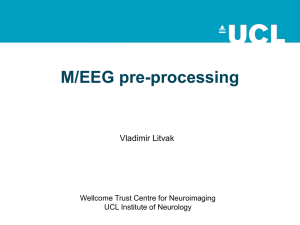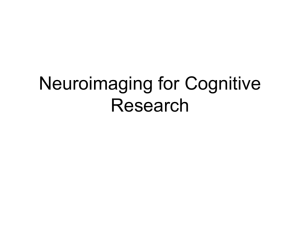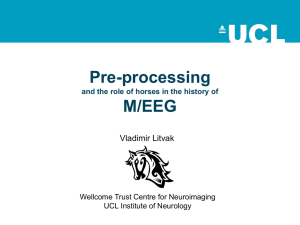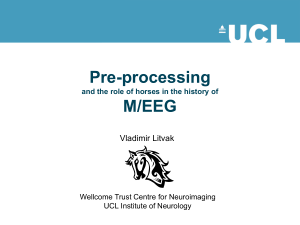EEG/MEG design
advertisement
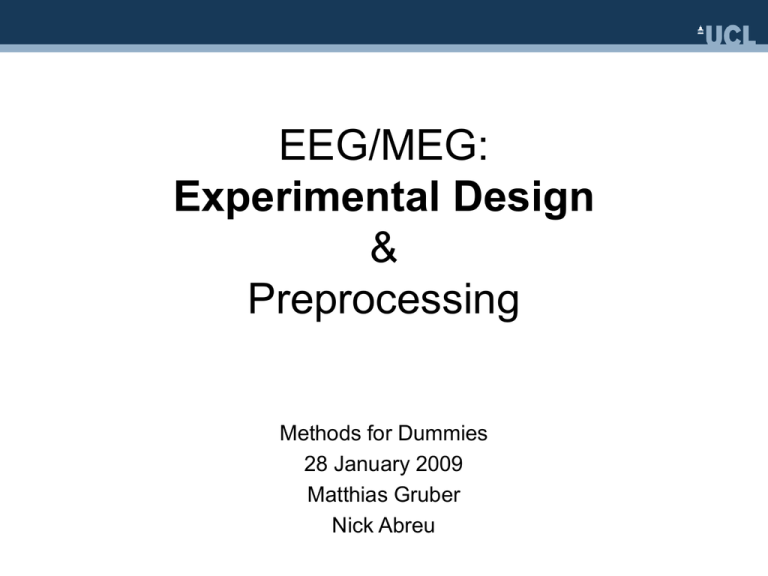
EEG/MEG: Experimental Design & Preprocessing Methods for Dummies 28 January 2009 Matthias Gruber Nick Abreu Outline - Design • Why EEG/MEG? • What is an ERP/ERF? • Interpretation/ Inferences from ERP/ ERFs – Based on prior knowledge (components) – Based on no prior knowledge • Electrode montage • General guidelines for a good design Why EEG/MEG? • • High temporal resolution EEG: comparably cheap • EEG/MEG or fMRI? – What is your hypothesis? – What method is the best to answer your question? What is an ERP/ ERF? ERP/ ERF: Event-related Potential/ Field Definition: the average (across trials/ subjects) potential/field at the scalp relative to some specific event in time Stimulus/Event Onset What is an ERP/ ERF? Averaging What is an ERP/ ERF? ERPs are signal-averaged epochs of EEG that are timelocked to the onset of stimulus Non-time-locked activity (noise) is lost to averaging How to interpret an ERP/ ERF waveform? ERP/ERF waveforms are often interpreted in terms of their constituent components Component (def) - Scalp-recorded electrical activity that is generated by a given patch of cortex engaged in a specific computational operation sensor + + + - Components Latent Components Observed Waveform OR OR many others… Any given electrode/sensor records a series of temporally overlapping latent components A given waveform could have arisen from many combinations of latent components Components Latent Components Observed Waveform The morphology of a component is not necessarily obvious from the observed waveform when components overlap What to do? How can one make valid inferences about latent components from observed waveforms? Experimental design! Design strategies • Focus on one specific component: Design experiment to stop other components from varying, especially temporally overlapping components • Focus on components that are well-known: well-studied experimental manipulations • Focus on large components: less sensitive to variations in others • Focus on easily isolated components • Test hypotheses that are component-independent Luck, S. J. (2005). Ten simple rules for designing ERP experiments, p. 17-33, Event-Related Potentials: A Methods Handbook. MIT Inferences not based on prior knowledge no prior knowledge = component-independent Define your ERP effect in four ways: • • • • Polarity Timing Amplitude Scalp distribution Inferences not based on prior knowledge • • • • Polarity Timing Condition 1 Amplitude Scalp distribution Condition 2 Fpz Fpz Word 2s + max Recognized Forgotten + Word 2s + max 5µV - max - max Electrode Montage What is my hypothesis? Where do I expect differences? Analysis of ERP effect (ANOVA design): Response (2) x Response (2) x Site (18) Anterior-Posterior (3) x Hemisphere (2) x Inferior-Superior (3) Place Hits - CR Memory test phase: Recollected – Correct Rejections 400-600 Analysis of ERP effect (ANOVA design): Response (2) x Sites (18) Response (2) x Anterior-Posterior (3) x Hemisphere (2) x Inferior-Superior (3) Anterior-Posterior (3) Hemisphere (2) Inferior-Superior (3) Frontal Central Parietal Inferior Left Right Medial Superior … developing a good design Specific EEG/ MEG issues: Amplifier setting small epochs General issues: trial numbers behavioural confounds Only few conditions EEG/MEG: Experimental Design & Preprocessing Methods for Dummies 28 January 2009 Matthias Gruber Nick Abreu M/EEG Preprocessing in SPM8 Overview • Goal: Raw data to signal-averaged ERPs or ERFs • How: – – – – – – – – – Data conversion Montage mapping Specify location of sensors Epoching Downsampling Filter Artefact Removal Signal Averaging Rereferencing SPM5 -> SPM8 • Better conversion of data from native format to flexible matlab format • New M/EEG data format • Interface with user – GUI or two different scripting methods suitable for automating multi-subject data analysis • Convert SPM data to FieldTrip or EEGLAB and back • Source Reconstruction and Effective Connectivity (see next week’s talk) Data conversion *.mat *.bdf *.dat • Native machine-dependent format a Matlab-based, common SPM format • Can also convert SPM5 data to SPM8 format by selecting the appropriate .mat file Data conversion • “Just read” – Easy, no questions asked • “Yes, define settings” • “Continuous v. trials” – Is machine-dependent data already divided into trials? • Follow-up q’s (see SPM8 manual) • “Which channels should be converted?” Montage mapping • Refine the number and types of channels used for further processing • User-defined – Script (see SPM8 manual) or GUI Montage mapping Review channel mapping Set up difference potentials (vEOG, hEOG) [1 -1] Rename channel labels Delete any unwanted channels (delete rows) Prepare (Specify location of sensors) • SPM can recognize common EEG setups (extended 1020, Biosemi, EGI) based on channel labels and assigns 'EEG' channel type and default electrode locations • But sometimes the user needs to specify additional info Prepare in SPM Review preprocessing steps (scripting) Change/review 2D display of electrode locations 1) Load recently converted file 2) Change/review channel assignments (EEG v. EOG) 3) Set sensor positions: -Assign defaults -From .mat file -From user-written locations file Epoching • Specify ‘epoch’ time window – Directly associated with triggers? • Specify [prestimulus time, poststimulus time] – Offset/unrelated to triggers? • Specify N x 2* matrix – each row contains start and end of a trial (in samples) • Automatic baseline-correction – The mean of the pre-stimulus time is subtracted from the whole trial. • Set category labels • Review individual trials by hand Epoching in SPM See if all trials are there For multisubject/batch epoching in future Issues in Epoching Segment length: At least 100 ms should precede the event onset (for baseline correction). The time - frequency analysis can distort the signal at both ends of the segment. Have padding (see SPM8 manual). The affected segment length depends on the frequency in an inverse manner (length ms ~ 2000/freq Hz) The segment should not be too long nevertheless, the longer it is the bigger the chance to include an artefact! (Tomalski & Kadosh 2008, MfD) Downsampling • Convert large dataset into smaller files – Useful when dealing with many subjects’ data • 512 Hz (large file) 200 Hz (takes up less than 50% amount of space as original file) Set new sampling rate (must be smaller than initial value) Filtering • Why filter? – EEG consists of a signal plus noise – Some of the noise is sufficiently different in frequency content from the signal that it can be suppressed simply by attenuating different frequencies, thus making the signal more visible • Non-neural physiological activity (skin/sweat potentials) • Noise from electrical outlets Filtering • SPM8 invokes Butterworth filter – Bandpass filter: e.g., 0.1 – 40 Hz • Caution – Any filter distorts at least some part of the signal – Gamma band activity occupies higher frequencies compared to standard ERPs Artefact Removal • Problem: Some trials contain BOTH signal of interest & a large amount of signal from other sources • What causes artefacts? – Eye movement – Eye blinks – Head movement • Talking, itching, etc. – Sweating – Swelling – ‘Boredom’ alpha waves Artefact Removal • Avoid having artefacts in the first place – Blinking – – – Avoid contact lenses Build ‘blink breaks’ into your paradigm If subject is blinking too much – tell them – EMG – Ask subjects to relax, shift position, open mouth slightly – Alpha waves – – – Ask subject to get a decent night’s sleep beforehand Have more runs of shorter length – talk to subject in between Vary ISI – alpha waves can become entrained to stimulus Artefact Removal • Hand-picked • Use of a more sophisticated Matlab algorithm • Automatic SPM functions – Thresholding • 2 passes (1st – bad channels, 2nd – bad trials) • Note: no change to data, just tagged to be rejected – Robust averaging • Estimates weights (0-1) indicating how artefactual a trial is Signal Averaging • S/N ratio increases as a function of the square root of the number of trials. • As a general rule, it’s always better to try to decrease sources of noise than to increase the number of trials. Rereferencing • Set appropriate reference (true, unbiased zero value) – Use of a single electrode, in theory free from any neuronal activity of interest • e.g., mastoid, vertex – Use of average across multiple electrodes, less susceptible to bias due to electrode location • “virtual electrode” Rerefencing in SPM • Familiar function – ‘Montage’ Reference to A1 electrode Rereferencing in SPM • Rereference to average electrode N = number of EEG channels Diagonals of matrix = (N-1)/N All other values in matrix = -1/N References • S. J. Kiebel: 10 November 2005. ppt-slides on ERP analysis at http://www.fil.ion.ucl.ac.uk/spm/course/spm5_tutorials/SPM5Tutorials.htm • J. Brooks and M. Joao: 13 February 2008. ppt-slides on EEG & MEG Experimental Design at http://www.fil.ion.ucl.ac.uk/~jchumb/MfDweb.htm • G. Galli: ppt-slides on methodological issues about ERP analyses. Presented at the CEUK Workshop 2008 in Stirling. • Todd, C. Handy (ed.). 2005. Event-Related Potentials: A Methods Handbook. MIT • Luck, S. J. (2005). An Introduction to the Event-Related Potential Technique. MIT Press. Thank you!


